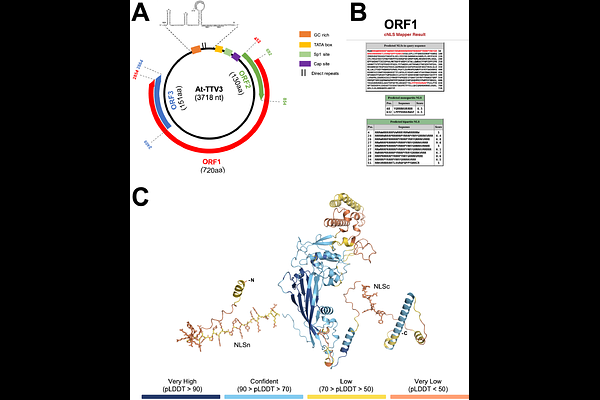Nuclear trafficking of Anelloviridae capsid protein ORF1 reflects modular evolution of subcellular targeting signals

Nuclear trafficking of Anelloviridae capsid protein ORF1 reflects modular evolution of subcellular targeting signals
Petersen, G. F.; Pavan, S.; Ariawan, D.; Tietz, O.; Nematollahzadeh, S.; Sarker, S.; Forwood, J. K.; Alvisi, G.
AbstractAnelloviridae members are ubiquitous viruses with a small, negative sense, single-stranded DNA genome which is replicated by host cell DNA polymerases. Anelloviruses are postulated to interact with the host cell nuclear transport machinery, however, the lack of reliable cell culture models strongly limits our knowledge regarding Anelloviridae-host interactions. In particular, capsid nuclear import is a largely uncharacterized process. We addressed this by investigating the relationship between host cell nuclear transport receptors (NTRs) and ORF1, the putative capsid protein from torque teno douroucouli virus (TTDoV). We identified the subcellular targeting signals and NTRs responsible for its nucleolar and nuclear localization, and characterized their relative contribution to ORF1 subcellular localization. In the absence of other viral proteins, ORF1 accumulated in the nucleoli. Bioinformatics analysis revealed a putative nuclear localization signal (NLS) within the highly conserved N-terminal arginine rich motif (ARM) (\'\'NLSn\'\', 27-RRWRRRPRRRRRPYRRRPYRRYGRRRKVRRR-57), and an additional C-terminal NLS (\'\'NLSc\'\', 632-LPPPEKRARWGF-643), which has been specifically acquired by Anelloviridae capsids with larger projection domains. Such NLSs play distinct roles in ORF1 subcellular localization. NLSn features broad importin (IMP) binding affinity yet plays a minor role in nuclear import, being responsible for nucleolar targeting likely through interaction with nucleolar components. NLSc specifically interacts with IMP and is the main driver of active nuclear transport in an IMP/{beta}1-dependent fashion. These findings suggest an evolutionary correlation between the acquisition of progressively larger projection domains and the presence of additional NLSs in Anelloviridae capsids, aimed at maximizing IMP/{beta}1-mediated nuclear import.